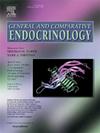夜间人造光和夜班工作对大脑功能和代谢的影响。
IF 1.7
3区 医学
Q3 ENDOCRINOLOGY & METABOLISM
引用次数: 0
摘要
目前的综述集中在夜间人造光(ALAN)和夜班工作(NSW)作为现代社会中发生的时间中断的例子。时间紊乱会导致严重的睡眠和健康问题,并增加患慢性病的风险。这种病理机制涉及内分泌系统(糖皮质激素、褪黑激素)。ALAN影响至少80%的人类,并扰乱野生动物的生理、生物和行为过程。在人类中,夜间使用照明屏幕会导致ALAN,对身体和大脑造成目前无法预见的后果。急性持续的光照射会引发大脑的促炎反应,这可能使大脑更容易受到额外的厌恶刺激。此外,急性连续光损害认知功能和突触可塑性,并导致皮质酮增加,皮质酮是一种应激激素,也是昼夜节律系统中的重要介质。一些关于新南威尔士州的研究报告称,睡眠障碍、癌症、心血管疾病、2型糖尿病、肥胖和抑郁症的风险增加。然而,客观成像分析辅以神经心理学检查显示NSW对脑功能只有轻微的影响。此外,最近的一项研究表明,新南威尔士州没有伴随代谢、心血管或免疫问题。综上所述,ALAN可能被认为是影响人类健康和生物多样性的相关因素,应尽可能避免。对NSW效果的研究报告了不同的结果。这可能是由于轮班期间光照强度的差异、职业卫生服务的质量和轮班工作安排。所有这些方面都需要进一步调查,以预防或减轻新南威尔士州的健康风险。本文章由计算机程序翻译,如有差异,请以英文原文为准。
Impact of artificial light at night and night shift work on brain functions and metabolism
The present review focusses on artificial light at night (ALAN) and night shift work (NSW) as examples for chronodisruption occurring in modern societies. Chronodisruption can lead to significant sleep and health problems and increase the risk of chronic diseases. This pathomechanism involves endocrine systems (glucocorticoids, melatonin). ALAN affects at least 80% of mankind and disturbs physiological, biological and behavioral processes in wildlife. In humans, the nighttime use of illuminated screens contributes to ALAN, with as yet unforeseeable consequences for body and brain. Acute continuous light exposure triggers pro-inflammatory responses in the brain which may make it more vulnerable to additional aversive stimuli. Moreover, acute continuous light impairs cognitive function and synaptic plasticity and leads to an increase in corticosterone, a stress hormone and an important mediator in the circadian system. Several studies on NSW reported increased risk for sleep disorders, cancer, cardiovascular disease, type 2 diabetes, obesity, and depression. However, objective imaging analyses supplemented by neuropsychological examinations revealed that NSW has only minor effects on brain functions. Moreover, a recent study showed that NSW was not accompanied by metabolic, cardiovascular or immunological problems. In conclusion, ALAN may be considered a relevant factor influencing human health and biodiversity and should be avoided whenever possible. Studies on the effects of NSW report varying results. This may be due to differences in light intensity during shift, the quality of the occupational health service and the shift work schedule. All these aspects need further investigations to prevent or mitigate the health risk of NSW.
求助全文
通过发布文献求助,成功后即可免费获取论文全文。
去求助
来源期刊

General and comparative endocrinology
医学-内分泌学与代谢
CiteScore
5.60
自引率
7.40%
发文量
120
审稿时长
2 months
期刊介绍:
General and Comparative Endocrinology publishes articles concerned with the many complexities of vertebrate and invertebrate endocrine systems at the sub-molecular, molecular, cellular and organismal levels of analysis.
 求助内容:
求助内容: 应助结果提醒方式:
应助结果提醒方式:


